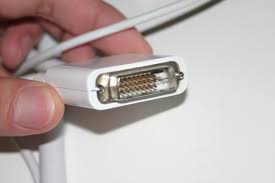Digital Video Interface (DVI) is a video display technology which superseded the VGA technology around 1999. Basically these cables help connect a video source (say a graphic card) to a display (a computer monitor). But the interesting thing is there are different technologies even to achieve such a simple task. The VGA, DVI and HDMI are a few prominent technologies in this field. In this article we help you understand everything you need to know about the different types of DVI Connectors.
Different Types of DVI Connectors:
The DVI connectors are of three types: DVI-A (analog), DVI-D (digital) and the DVI-I (integrated). Based on the data rates, these are further divided as the single-link and dual-link types. First we try to understand what difference these link types have so that we can understand the various DVI connectors easily.
Any DVI connector uses the Transition Minimized Differential Signaling (TDMS) through a pair of twisted wires to transmit data. A single-link DVI connector contains four such TMDS links. Each one of these TMDS links corresponds to the Red, Green, and Blue video signals. The extra TMDS link is a clock control channel. These single-link channels can support resolutions of 1920×1200 at refresh rate of 60Hz. These connectors operate at maximum of 165 MHz and offer a bandwidth of 1. 65Gbps.
The dual-link connectors have double the number of TMDS pairs than the single-link DVI. These connectors do not have a clock pair and thus enable 2Gbps of bandwidth. These are backward compatible with single-link types and support resolutions up to 2560×1600 at 60Hz refresh rate. But a single-link connector cannot support dual-link connections at any time. Hence a dual-link type connector is preferred mostly.
(Actually in a single-link type one TDMS transmitter is employed to send digital information to a receiver in the monitor, while the dual-link type uses two transmitters.)
Image courtesy by : Deltapage
The Different types of DVI Connectors and Cables(In Detail):
DVI-Analog (DVI-A) is a analog only format. It has 17 (12+5) pins and only carry analog signals. These connectors do not have a dual-link option. Though these signals are identical to the VGA signals but are presented with quite a few alternations. A VGA to DVI adapter is required to connect a VGA video card to the DVI-A type monitor (or DVI-A video card to VGA monitor). But due to some reasons DVI-A cables are quite rare. Either you can find a VGA (for analog) or DVI-D, DVI-I (for digital) more abundantly than a DVI-A.
DVI-Digital (DVI-D) cables are capable only of transferring video signals in the digital form. The DVI-D connector contains 3 rows of 8 pins and a grounding slot in case of dual-link type (which means 24+1 pins). For single-link there are 18 pins in total and a ground pin (18+1). The specialty of these cables is they work with both DVI-D and DVI-I connectors. Generally DVI-D connectors are the one you can find on most of the monitors.
DVI-Integrated (DVI-I) cables support the transmission of both digital and analog signals (but doesn’t convert signals between analog and digital). A single link DVI-I has a 23 (18+5) pins and a total of 29 pins in the dual-link connectors. These cables can be used to connect to a monitor which accepts any of the digital or analog signals. Like the name goes, the DVI-I connectors can work with all the three DVI cable types. But a DVI-I cable cannot work with all the DVI connector types. This is a point you should note.
Simply speaking, the DVI-D cable is most applicable of all the three cable types and the DVI-I connectors are the best.



The DVI to DVI and also Analogue Adapter assist you to essence either analogue video and/or digital DVI-D video from an individual video root (normally a computer video card).
Easily connect the DVI-I connector from your video resource to the put in area of the wire. Connect the analogue and/or DVI-D outputs to exhibit units (monitors or even projectors) .